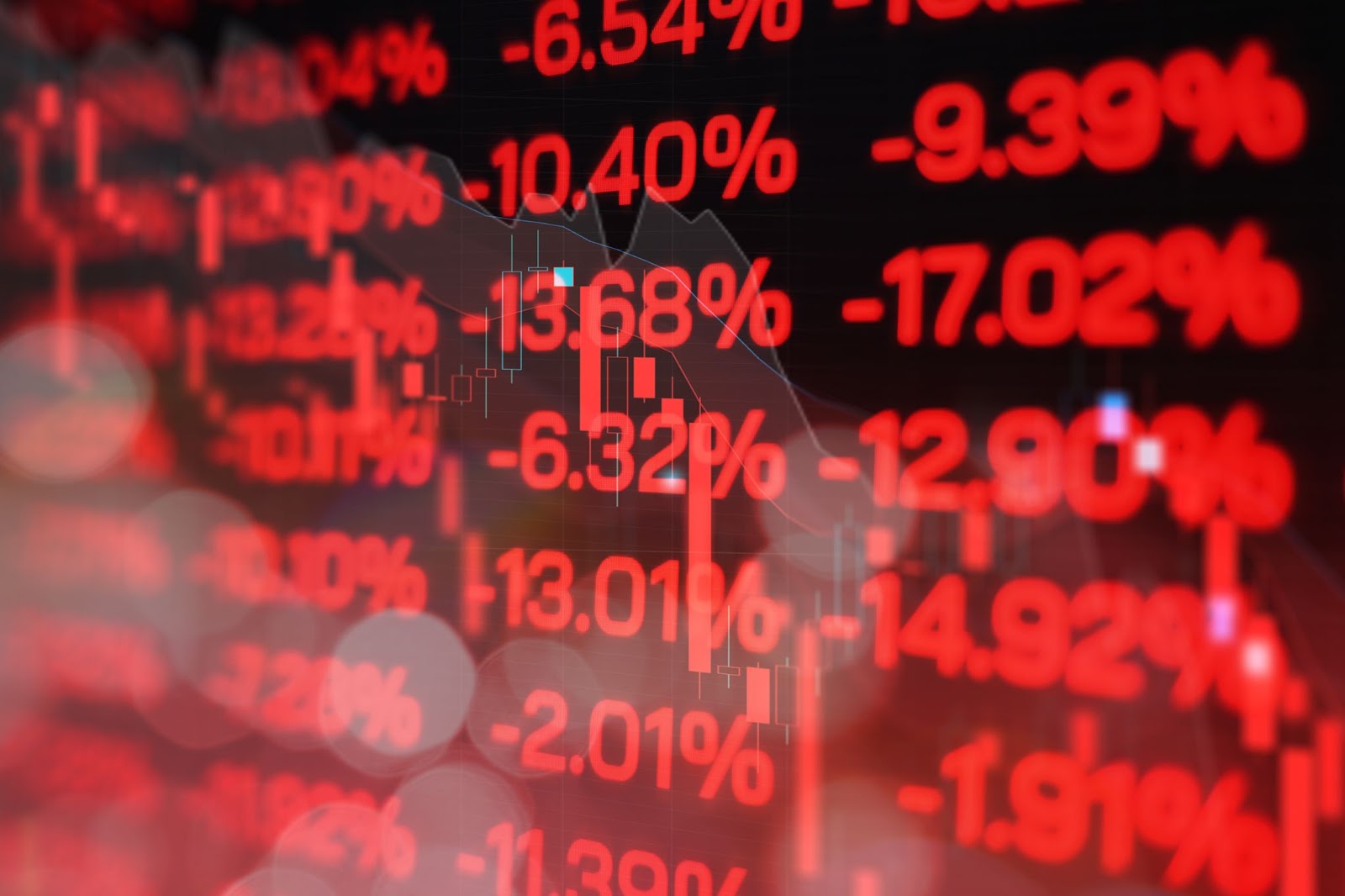The Dow Jones Industrial Average has fallen for nine consecutive days, sparking concerns among investors as the “Dow down 9 days in a row” phenomenon raises questions. What is driving this unusual losing streak? In this article, we examine the key factors behind the Dow’s downturn and its potential impact on the market.
Key Takeaways
- The Dow Jones experienced its longest losing streak since 1978, closing down 267 points or 0.61%.
- Key factors contributing to the decline include significant drops in major stocks like UnitedHealth, Apple, and Nvidia, coupled with political and economic uncertainties.
- Investors are increasingly turning to commodities and precious metals, especially gold, as safe havens during this period of heightened market volatility.
The Dow’s Nine-Day Losing Streak: An Overview

The Dow Jones Industrial Average has seen better days. Recently, it closed lower, pulling back more than 267 points, or 0.61%, finishing at 43,449.90. This marks a notable nine-day losing streak, the most extended decline observed in recent history. Such a prolonged downturn is rare and has not been witnessed since 1978, making this performance particularly noteworthy.
Investors are understandably concerned. The implications of this losing streak extend beyond mere numbers and percentages. It affects investor sentiment and long-term market strategies, prompting a need for careful analysis and potential adjustments to portfolios. This trend has the potential to reshape market behaviors and strategies in the coming months.
Historical Context: Longest Losing Streak Since 1978
The recent nine-day decline of the Dow is the longest since February 1978. Back then, the market faced a similar downturn, indicating that such events, while rare, are not unprecedented. This historical context offers valuable insights into past performance and recent history for market observers and analysts.
This comparison underscores the significance of the current market situation. While history may not repeat itself exactly, it often rhymes. The current losing streak, similar to the one in 1978, signals a critical moment for the stock market, necessitating careful observation and analysis by investors and analysts.
Key Factors Driving the Decline
Several factors are driving the Dow’s recent downturn. A significant factor is the substantial drop in UnitedHealth’s stock, which has decreased by over 20% since December 2022. The Dow’s structure makes it particularly vulnerable to fluctuations in high-priced stocks like UnitedHealth, Apple, and Microsoft. These stocks have a disproportionate impact on the index, amplifying the effects of their declines.
Additionally, performance issues with Nvidia and concerns regarding shifts in AI applications have weighed down the index. The concentration of market activity in a few technology stocks has resulted in broader market volatility, with many stocks in the S&P 500 also declining. This has created a ripple effect, exacerbating the Dow’s losses.
Political uncertainty and economic recovery expectations are also significant contributors. Uncertainty regarding healthcare reforms under the Trump administration has added to market instability. Lowered expectations for overall economic recovery have particularly impacted cyclical stocks such as Caterpillar, adding to the market’s woes.
Impact on Investors and Portfolios

The recent decline in the Dow Jones Industrial Average reflects a notable shift in market sentiment and investor concerns over economic stability. Market reactions to the Dow’s performance influence investor sentiment across various sectors, impacting decisions on asset allocation and portfolio adjustments. This widespread sell-off reflects investor anxiety and speculation in response to significant downturns like the Dow’s nine-day decline.
Global economic uncertainties, including geopolitical tensions and monetary policy shifts, have influenced the market’s behavior significantly. These factors have increased market volatility, affecting both individual investors and large investment funds and mutual funds. Broader market trends reflect this anxiety, leading to further instability.
Market Volatility and Retirement Accounts
Volatility in the market has a pronounced impact on retirement accounts and retirement assets. Investors who opened accounts during the pandemic have displayed higher investment risks compared to those who opened accounts at other times. Although average retirement account balances have dropped slightly from the previous quarter, they have shown an increase compared to last year and over the past decade.
In response to fluctuations, investors are increasingly turning to gold as a protective measure. Diversifying portfolios and reallocating assets toward stable investments are crucial for safeguarding retirement accounts during volatile periods. This trend underscores the importance of having a diversified portfolio to mitigate risks.
Financial advisors play an essential role in guiding investors through these turbulent times. They help implement strategies that focus on long-term goals, ensuring that investors maintain a disciplined approach despite market volatility. Managed accounts have become more popular, providing personalized investment strategies to help investors stay aligned with their retirement goals.
Commodities and Precious Metals as Safe Havens

During market declines, commodities and precious metals are often viewed as safe havens. Physical precious metals, such as gold coins, and physical metals are classified as non-regulated products. While considered a secure investment, these metals can also be speculative, exposing investors to certain risks.
Despite these risks, the stabilizing effect of commodities and precious metals during market downturns is significant. They provide a hedge against volatility, offering investors a way to preserve capital when traditional stocks and bonds underperform. This makes them attractive for those looking to mitigate losses during economic uncertainties.
Gold Prices and Investor Behavior
Gold prices have been rising as investors seek gold ira to protect against fluctuations. This trend highlights the increasing appeal of physical gold and other precious metals as safe-haven investments. Investors are looking to buy gold coins and other forms of precious metals iras to diversify their portfolios.
This behavior underscores the broader implications for investment strategies and market stability. As more investors turn to gold and other stable assets, it reflects growing caution in the face of market volatility. This shift could lead to a more balanced approach to investing, focusing on preserving value rather than chasing high returns.
Summary
The Dow’s nine-day losing streak marks a significant event in recent stock market history. This unprecedented decline has been driven by a combination of factors, including performance issues in key stocks, political uncertainty, and broader economic concerns. The impact on investor sentiment and market strategies has been profound, prompting a reevaluation of asset allocations and investment approaches.
As we look ahead, it’s crucial for investors to stay informed and consider their strategies carefully. Diversifying portfolios, seeking stable investments like precious metals, and working with financial advisors can help navigate these turbulent times. By staying vigilant and adaptable, investors can better prepare for future market fluctuations and protect their financial well-being.
Frequently Asked Questions
What triggered the recent decline in the Dow Jones Industrial Average?
The recent decline in the Dow Jones Industrial Average was primarily triggered by a significant drop in UnitedHealth’s stock, coupled with underperformance in high-priced stocks like Apple and Microsoft, and broader economic uncertainties.
How does the current losing streak compare to past performances?
The current nine-day losing streak is significant, as it marks the longest since February 1978, highlighting a disturbing trend in recent market performance.
What are the main factors driving this market decline?
The main factors driving the market decline are significant drops in high-priced stocks, underperformance in tech stocks, political uncertainty, and lowered expectations for economic recovery. These elements are creating a challenging environment for investors.
How does market volatility impact retirement accounts?
Market volatility can lead to declines in retirement account balances, making diversification and consultation with financial advisors essential strategies to protect your investments and maintain stability.
Why are commodities and precious metals considered safe havens?
Commodities and precious metals offer a reliable store of value during market volatility, making them effective for capital preservation in economic downturns. Consequently, they are widely regarded as safe havens for investors.
